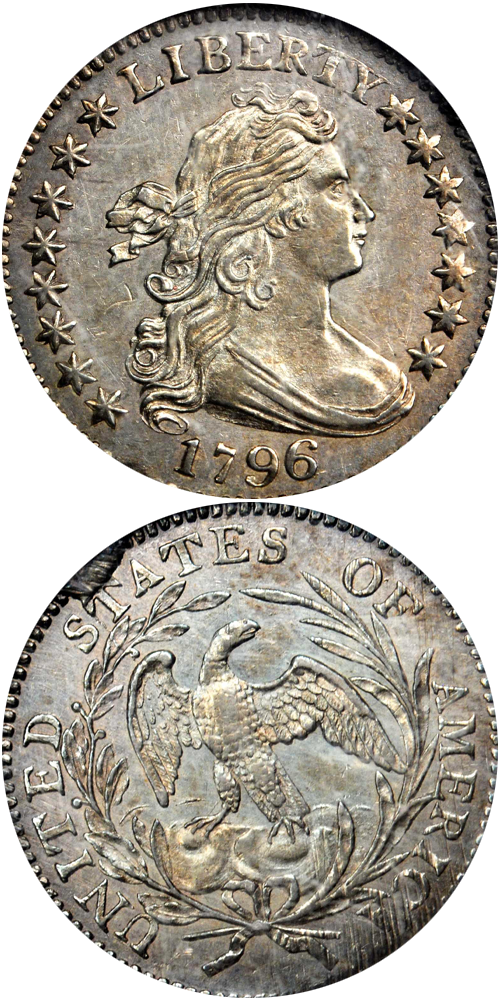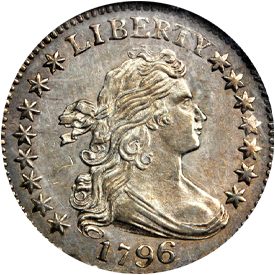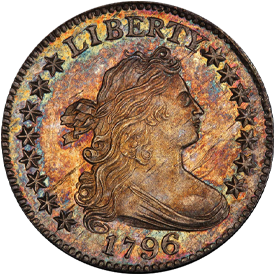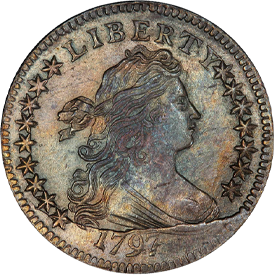Designed by: Robert Scot
Issue Dates: 1796-1797
Composition: 89.24% silver, 10.76% copper
Diameter: 19 mm
Weight: 2.69 grams (41.51 grains)
Edge: Reeded
Business Strike Mintage: 47,396
Proof Mintage: None
The design of the 1796-1797 dime parallels that of the contemporary half dime. The obverse depicts Miss Liberty with flowing hair, a ribbon behind her head, and drapery covering her plunging neckline. LIBERTY is above and the date is below. Thirteen obverse stars are to be found on the 1796 dime, while dimes of 1797 come with either 13 or 16 obverse stars. The reverse consists of an open wreath, tied with a bow at the bottom, enclosing a small eagle perched on a cloud, with UNITED STATES OF AMERICA surrounding. No indication of denomination or value appears.
Examples of this type are most often encountered in lower grades from About Good to Fine. Very Fine examples are scarce, Extremely Fine pieces are rare, and coins in higher ranges are very rare. Occasionally an AU or Uncirculated 1796 dime will be found, but few pieces dated 1797 exist in Mint State or close to it. Mint-caused adjustment marks are often seen, as are areas of normal light striking. These pieces were meant strictly for utilitarian use, and no thought was given to producing pieces for collectors.
Further Reading
Dimes or 10-cent pieces are just one of four denominations which have been coined continuously (more or less) since the 18th century (joining the cent, quarter, and half dollar). The first pieces made their appearance in 1796. The Draped Bust obverse, similar to that used on half dimes of the year, was combined with the Small Eagle reverse, also similar to the smaller denomination. From this time forward the designs of dimes follow those of contemporary half dimes in nearly all instances.
The motif is characterized by the draped bust of Miss Liberty facing right, with stars to the left and right, the word LIBERTY above, and the date below. The reverse illustrates a "small" eagle perched on a cloud, enclosed within a wreath, encircled by the inscription UNITED STATES OF AMERICA. The edge is reeded. Interestingly, no mark of denomination appears on early dime issues. It was not until 1809 that a mark of value, 10 C. was used for the first time. The obverse of the style, the Draped Bust, is from a design first used on the silver dollar of 1795, and is said to have been the suggestion of noted artist Gilbert Stuart (who is probably best remembered today for his painting of George Washington, reproductions of which are a familiar sight in schools across the land).
Figures given in A Guide Book of United States Coins note that slightly over 47,000 dimes were made of the 1796 and 1797 years combined, in contrast with a reported 55,000 for half dimes of the same years. And yet dimes today seem to be considerably less scarce than half dimes. The explanation is unknown.
A number of die varieties exist of the first two years of dime issuance. Most distinctive are the 1797 pieces with two different star counts, 13 and 16 on the obverse. While undoubtedly even a cursory study of old auction records would reveal that one variety is rarer than the other, values are about the same, for most of the demand for dimes of 1796 and 1797, irrespective of variety, is from type set collectors.
Until 1984 there was no comprehensive book specifically treating dimes from 1796 onward. The scholar could piece some information together from Abe Kosoff's cataloguing of the F.C.C. Boyd Collection in 1945. This sale catalogue attributed dimes by "K" (for Kosoff) numbers and has achieved some popularity. Kamal M. Ahwash published the Encyclopedia of United States Liberty Seated Dimes 1837-1891 in 1977, a guide which covers that particular series.
In 1984 a masterful treatise appeared, Early United States Dimes 1796-1837, the work of five authors: David J. Davis, Russell J. Logan, Allen F. Lovejoy, John W. McCloskey, and William L. Subjack. The preface to the volume is by Walter Breen, who noted in part: "This book is an important contribution to the still incomplete corpus of studies on American federal coinages. In the long run it may prove to be at least as much of a turning point for collectors of early United States silver as Sheldon's Early American Cents was for collectors of early copper coins, though without falling into the traps of the Sheldon book. I am most pleased to recommend this splendid piece of research to collectors of the entire American series. Read it and learn!"
The authors of the volume are collectors, and they have written the tome from a collectors' point of view. Listings for each year are prefaced by notes, some of which are quite fascinating. All in all, the book furnishes a great passport to a journey among early coins of the denomination.
Dimes of the 1796-1797 years are most often seen in worn grades and are fairly scarce. Often specimens show some degree of surface striations or porosity. This seems to be especially true of those dated 1797. Although occasionally Uncirculated 1796 dimes are seen, perhaps saved as the first year of issue, Uncirculated 1797 pieces, minted a year later, are extreme rarities. Certain 1796 dimes exist with prooflike surfaces and may have been presentation pieces. Walter Breen in his Encyclopedia of United States Proof Coins cites the survival of at least a dozen such pieces. 1796 quarters and half dollars are likewise occasionally seen with prooflike surfaces.









